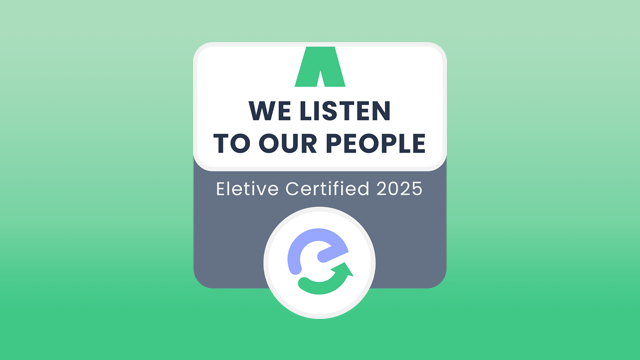Employee wellbeing is closely connected to performance, employee retention and employee satisfaction. And to happy customers! So, how can you improve employee wellbeing?
Imagine waking up on a Monday morning, the familiar sound of your alarm clock signalling the start of the week. Instead of dreading the days ahead, you feel invigorated and ready to tackle the challenges that lie ahead. Why?
Because you're part of a company that prioritises the well-being of its employees—a workplace that actively prevents burnout and values mental health.
This isn't a utopian dream; it's a reality that many forward-thinking HR leaders are embracing.
Join us as we explore how you can cultivate healthier and more enjoyable work environments for everyone involved.
From enhancing engagement through platforms like Eletive to providing anonymous communication channels, each strategic move is aimed at building a more connected and engaged workforce.
Welcome aboard as we delve into the key practices that can transform workplaces into spaces where both productivity and well-being thrive.
What is employee wellbeing?
Employee wellbeing isn't just about physical health. It encompasses a combination of psychological, affective and communal aspects which form an individual's labour experience.
The concept goes beyond the absence of illness. Rather, it requires establishing an atmosphere where personnel are valued, content and enabled to deliver their finest.
When personnel have good mental, physical and emotional health they are more probable to be effective and committed in their work.
According to Deloitte, most C-suite leaders (85%) believe that companies should share their workforce well-being metrics publicly, but only about half (50%) currently do so
That said, sometimes getting these metrics is hard enough; which is where Eletive can help you.
A comprehensive approach towards employee wellbeing addresses various aspects such as stress management strategies; healthy eating habits; exercise programmes; flexible working hours or arrangements allowing for better work-life balance.
Engagement-graph:format(jpeg)/f/288714721386412/f8d13c1d33/engagement.jpg)
Why is employee wellbeing important? What are its benefits?
The importance of staff welfare can be underscored by its direct impact on performance and productivity.
In 2019, 84% of employers observed increased productivity and enhanced performance from their workforce as a result of wellness initiatives according to Zippa.
This is because when we feel good, we work better. We're more centred, spurred on and eager to face whatever lies ahead. And there's an added bonus: teams with higher well-being are often more creative, too.
Beyond individual benefits, company-wide health initiatives also lead to lower turnover rates - another boon for businesses. According to the CIPD, companies that prioritise worker health report 44% less sick leave and see a whopping 31% reduction in resignations.
A happier team equals better results - simple as that.
Creativity gets unleashed when people are feeling great about their work environment.
Loyalty grows stronger – healthy workers stick around longer saving recruitment costs down the line.
Better team morale: A focus on health sends a clear message - we care about you. This leads to more positive feelings within the team leading to better cooperation.
Nurtures creativity: When people are feeling good they're more likely to think outside the box, helping drive innovation forward.
Currently, just 9% of the worldwide workforce has access to workplace wellness programs.
Neglecting wellness and well-being concerns comes at a substantial cost. The Global Wellness Institute reports that the global expense of unwell workers accounts for 10-15% of the entire global economic output.
Implementing regular pulse surveys to gauge employee engagement and well-being serves as a valuable strategy for addressing and improving workplace wellness.
Related reading: What is a pulse survey? Complete guide with examples | Eletive
7 useful strategies to improve employee wellbeing at work
Let's have a look at some of the actionable steps you can take to increase the level of employee well-being in the workplace.
1. Boost employee engagement
A key element in enhancing employee wellbeing and engagement is making work meaningful. You see, when employees feel their contributions matter, they're more likely to stay motivated.
Now you might ask, how can we make work seem meaningful? Acknowledge the work done by your staff to make them feel that their efforts are valued. When staff are appreciated for their efforts, it gives them the feeling that they're contributing something valuable.
Involving your team in decision-making also helps boost engagement. This furnishes staff with a sense of having an ownership stake, as well as making them feel esteemed by the company.
We can't forget about training opportunities either. Offering professional development shows you’re invested in your employees' futures - just another excellent method to keep spirits high.
Show appreciation regularly – even small wins deserve celebration.
Foster an environment where everyone's opinion matters by including all levels of staff in decisions impacting their work lives.
Growth should be encouraged - offer regular training sessions or seminars on new industry trends and developments to help your team improve skills and knowledge base.
By boosting employee engagement this way, not only will you get happier workers but increased productivity too—truly hitting two birds with one stone.
2. Don’t neglect mental health
Mental health matters just as much, if not more, than physical wellbeing. It's often hidden but its effects are significant on employees' work performance and personal life.
An empathetic approach is crucial to tackle this sensitive issue. Start by acknowledging the importance of mental wellness in your workplace culture. Encourage open conversations about stress or anxiety issues without fear of judgement.
Organisations taking proactive steps towards identifying and addressing employee mental health concerns perform better overall. This is because they foster an environment where everyone feels valued and heard.
Create a strategy for tackling it in an empathetic way
To create a meaningful change, develop a holistic strategy focusing on both prevention and intervention measures.
Prevention strategies could include offering flexible working hours to reduce burnout or conducting regular mindfulness sessions. For intervention, consider partnering with professionals who can provide support when needed most - such as psychologists or therapists.
The aim should be creating safe spaces where staff feel comfortable sharing their feelings openly; knowing they will get the help they need rather than being stigmatised or judged negatively for their struggles.
3. Implement employee wellbeing initiatives
Implementing effective employee wellbeing initiatives is a crucial step toward fostering a healthier and more engaging work environment.
These initiatives go beyond mere rhetoric, actively promoting physical, mental, and emotional wellness among your workforce. Here are some practical ideas to consider:
Flexible work arrangements
Offer flexible work hours or remote work options to accommodate employees' diverse needs and promote work-life balance.
Implement policies that support a healthy integration of professional and personal responsibilities.
Team building activities
Organise team-building events and activities to strengthen interpersonal relationships.
Encourage collaboration and camaraderie through social events, both in-person and virtual, fostering a positive and supportive work culture.
Recognition and rewards
Implement a robust employee recognition program to acknowledge and celebrate achievements.
Offer meaningful rewards, such as extra time off, personalised gifts, or professional development opportunities, to show appreciation for hard work.
Health checkups and screenings
Provide on-site health checkups and screenings to proactively address and prevent health issues.
Collaborate with healthcare professionals to offer vaccinations, flu shots, or seminars on preventive health measures.
Training and skill development
Invest in training programs that focus on skill development and career growth.
Support employees in pursuing courses or certifications that align with their personal and professional goals.
4. Measure your eNPS score
Your Employee Net Promoter Score (eNPS) is a bit like the pulse of your company. It's one key sign to show how healthy or unhealthy things are on the inside.
You can measure it with Eletive by asking just one question: "On a scale from 0-10, how likely are you to recommend working here to a friend?" Employees who respond with scores between 9 and 10 are promoters. Those who give scores from 7-8 are passives, while anyone scoring below that is seen as detractors.
Enhance your eNPS measurement with Eletive. Our tool streamlines the calculation process, recording all responses anonymously and presenting the results in a clear format. This enables everyone to identify areas for improvement collaboratively, fostering a constructive approach without attributing feedback to specific individuals.
Keep in mind, recognizing areas for improvement is just the first step. It's important to roll up your sleeves and put in the effort. Once you have these insights, don't overlook the action planning phase. Take concrete steps toward improvement based on the feedback you've received.
5. Embrace anonymity
Creating an atmosphere of anonymity can foster a productive and unbiased dialogue. It lets your team speak up without fear of judgement or discrimination, encouraging open and honest communication.
Creating a secure atmosphere in which all personnel can express their views is paramount. That's why at Eletive we've developed our Anonymous Employee Chat. This feature allows employees to give feedback that’s frank and constructive, helping you get to the heart of any issues more quickly.
But it's not just about addressing problems - anonymity also helps foster creativity and innovation. With no risk of criticism or rejection, employees are more likely to share bold ideas which could transform your business.
You see, embracing anonymity isn't just about problem-solving – it's also an engine for growth.
6. Implement a whistleblowing channel
A vital element of generating a positive workplace atmosphere is ensuring personnel feel secure. That's where the Eletive Whistleblowing Channel comes in.
This tool lets your team report misconduct and unethical behaviour, creating an atmosphere of trust and transparency. But it isn't just about calling out the bad stuff—it's also a powerful way to protect employee wellbeing.
Misconduct can drain morale faster than you'd think, but Eletive helps nip that problem in the bud. How? By providing a platform for employees to voice their concerns without fear or favour—no need to worry about office politics getting in the way here.
Fostering trust with anonymity
Anonymity is key when reporting sensitive issues; no one wants their name attached to potential fallout from blowing the whistle on misbehaviour. And this doesn’t only help those raising concerns: it makes management’s job easier too. The last thing anyone needs is guesswork clouding judgement during investigations.
Benefits of a safe reporting environment
Beyond peace of mind, anonymous whistleblowing channels give benefits like increased staff retention rates and improved workplace harmony—yes please. It all leads back to boosting employee engagement and satisfaction levels, which are vital ingredients for organisational success.
7. Individual action plans
A vital strategy to boost employee wellbeing is to let employees create and track their own action plans for personal and professional development. It's like handing them the compass of their career journey, letting them navigate towards growth.
The beauty of this approach lies in its two-fold impact. On one hand, it allows individuals to align their actions with business goals, making work more meaningful for them. On the flip side, it gives supervisors an opportunity to comprehend what drives each colleague.
Eletive steps into this process by providing an Individual Action Plans feature. This tool lets your workforce connect their day-to-day tasks with survey results that reflect overall company objectives. It’s like giving your staff a personalised roadmap towards improvement while staying attuned to organisational targets.
But here’s where Eletive goes above and beyond – we’ve made sure tracking progress isn't tedious or intimidating but empowering instead. Employees can monitor how well they're doing against these plans regularly.
In essence, individual action planning doesn’t just improve job performance; it boosts morale too. When employees see tangible progress linked directly back to their efforts - that's motivation at its finest.
How to improve employee wellbeing: example
Rutgers, an NGO based in the Netherlands, has partnered with Eletive to revolutionise its workplace culture. Facing limitations with traditional annual surveys, Eletive's data-driven approach empowered employees and managers, fostering transparency and a feedback-driven culture.
Pulse surveys now enable Rutgers to swiftly address employee perceptions, prevent burnout, and prioritise the wellbeing of its passionate workforce, resulting in tangible improvements to their workplace culture.
Eletive customer case Rutgers:format(jpeg)/f/288714721386412/6ce615ce31/rutgers.jpg)
Conclusion
Boosting employee wellbeing isn't a tick-box exercise, but an ongoing commitment. By now, it should be clear why boosting employee wellbeing is essential for both individuals and organisations, as well as how positive the effects on morale can be when mental health is addressed in an empathetic manner.
Fortunately, with employee feedback software like Eletive, creating healthier workplaces becomes not just achievable but straightforward too!
FAQ
How to promote the wellbeing of employees?
To boost employee wellbeing, make sure your workplace promotes a healthy work-life balance. Offer flexible hours and support for physical and mental health.
What are the five strategies to promote wellbeing?
The key steps are:
Promote work-life balance
Encourage regular breaks
Foster positive relationships at work
Support personal development and growth
Prioritise mental health
How can leaders improve employee wellbeing?
Leaders need to lead by example in promoting a positive culture. They should encourage open communication, recognise achievements regularly and offer help when needed.
How can you contribute to the wellbeing of employees?
You could give support by listening to their concerns or offering advice. It's also important to foster an inclusive environment where everyone feels valued

As Team Manager, Customer Success at Eletive Emelie is helping organisations build workplaces where people thrive. In her role, she enables delight among our customers and leads the Customer Success team to excellence.

























:format(jpeg)/f/288714721386412/b17e5c4769/blog-strategies-to-improve-employee-wellbeing-hero_media.jpg)
:format(png)/f/288714721386412/70a5012076/blog-eletive-secures-growth-investment-from-accel-kkr-hero_media.png)
:format(jpeg)/f/288714721386412/a906f14dff/blog-hr-trends-2026-ai-data-and-employee-experience-hero_media.jpg)
:format(png)/f/288714721386412/9f8e0a2347/blog-beyond-the-hype-the-new-rules-of-people-success-in-a-global-ai-powered-hero_media.png)